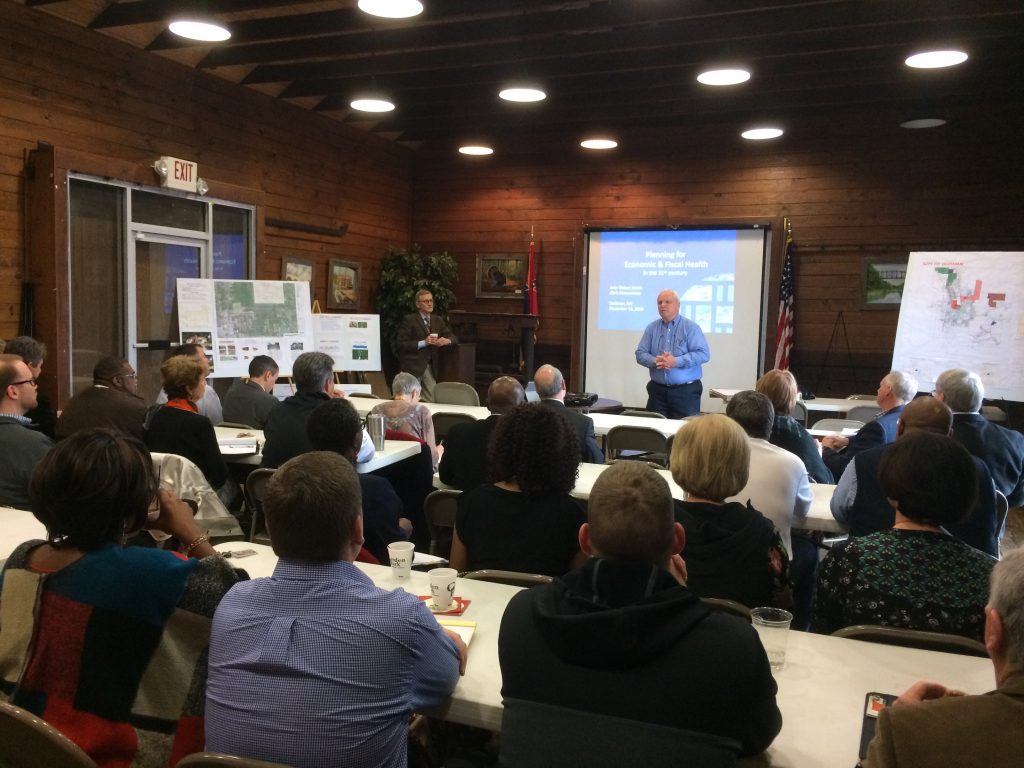
News
By Brian Lutenegger, June 22, 2017

Quitman, MS (population 2,209) is a cozy town in eastern Mississippi that prides itself on its locally owned Main Street businesses, banking and health care industries, commitment to green practices, and fiber optic internet access.
Quitman wants to build on these assets, and leaders are looking for ways to grow the town's economy and revitalize the town center. To help do that, Quitman leaders applied for and won a Foundations of Smart Growth technical assistance workshop as part of our program in partnership with the U.S. Environmental Protection Agency. After talking with the town about their ideas and plans, we also awarded Quitman a Fiscal Impact Analysis at no cost, as part of our Rural Development program in partnership with the U.S. Department of Agriculture. Our Fiscal Impact Analysis is a data-intensive model designed to show how different development scenarios could impact future public finances.
In preparation for the workshop, our technical assistance team worked with Quitman to look for economic "hot spots"—clusters of high-value parcels that can show where future development is likely to be successful. The two hotspots our team identified are located downtown and near Archusa Creek Lake, a popular recreation area. They represent just 5 percent of Quitman’s land area and only 13.4 percent of the city’s roads, but make up more than 32 percent of the city’s overall property value. By taking a more compact approach to its growth patterns in these spots, the town could produce more revenue over time, and at less cost to taxpayers.
Our team also analyzed six potential investment sites for redevelopment. Of the six parcels, only one—a lumber yard—is located within walking distance of either hotspot. The lumber yard represents the most promising opportunity by far to support the town’s vision of a vibrant, walkable town center. Redeveloping this site would produce the greatest return on public dollar investment. The five other parcels are located in more remote areas, and municipal infrastructure costs for roads, utilities, and other services to those parcels would be higher due to their distance from other dense development—resulting in lower revenue to the community from any new development.
Our technical assistance team then traveled Quitman in December 2016 to hold the in-person workshop and present the results of our analysis. The workshop gave elected leaders, business owners, and civic officials an opportunity to take stock of the city’s history and its current needs in order to craft an aspirational vision for Quitman’s future. At the workshop, Quitman residents and leaders voiced a desire to build more walkable, vibrant town center and attract new and younger citizens. With the help of Smart Growth America’s Fiscal Impact Analysis, Quitman learned just how impactful focusing growth around key spots in town can be.
For many small communities, revitalization strategies that create walkable town centers can seem prohibitively expensive. But many communities are realizing that these higher up-front costs come with decades-long financial dividends. Rifle, CO is one such place, where our Fiscal Impact Analysis made clear the economic potential of this type of investment.
For towns like Quitman, the prospect of lower long term cosst can present a new lease on financial well-being. Taking stock of how to make sure that existing infrastructure is financially manageable for the long haul is the key to establishing sustainable growth and long term prosperity.
Learn more about our work with Quitman in the workshops materials below.
Workshop Materials:
- Planning for economic and fiscal health tool description (PDF)
- Fiscal Impact Analysis tool description (PDF)
- Quitman: Evening Presentation (PDF)
- Quitman: Case Study for USDA (PDF)
- Quitman: Next Steps Memo (PDF)
- Quitman: Progress Report – One Month (PDF)
- Quitman: Progress Report – Six Month (PDF)
- Quitman: Progress Report – Twelve Month (PDF)
Is your community interested in our technical assistance? Learn more about the services we offer ››
Related News

© 2025 Smart Growth America. All rights reserved
Site By3Lane Marketing








